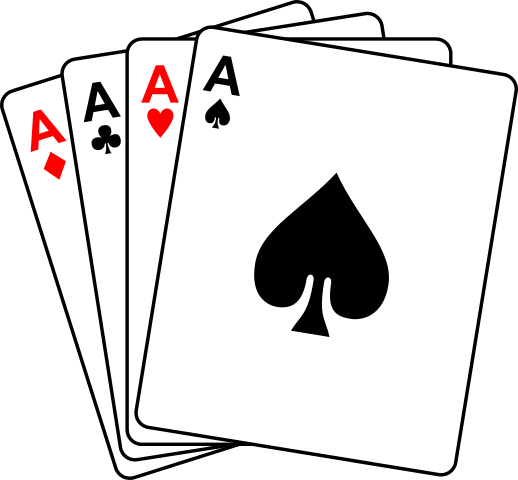5 Aces Poker
Posted By admin On 13/04/22Photo about Poker hand with 5 aces, 2 aces of spades. Image of winner, cheater, holdem - 437206. Double Double Bonus Video Poker. Double Double Bonus, also known as 10/6 video poker, is another popular variant based on Jacks or Better. This game also uses the standard 52-card deck and offers all the same video poker fun and more. What makes this variant special is that it pays a premium for all hands containing Four of a Kind. 39 mm diameter casino sized chips are 11.5 grams in weight Produced from a composite resin and an insert that gives them the weight feel of a heavy casino quality chip All chips have a colorful image of a 4-of-a-kind poker hand in aces. Ace$ (FP) vpFREE2 has 4 unique pay tables for the A-c-e-s Bonus (aka: Ace$) video poker game. Of these, vpFREE2 considers 1 game 'good' or 'playable', under typical circumstances, with a return of at least. Another bet is available (similar to the Pairplus in Three Card Poker), based only on the player's four card hand, called the Aces Up. Seven pay tables are available as indicated below. The only one I know of to be actually used is pay table 5.
Table Of Contents
In case you don't already know, poker is a game of maximizing wins (when you have the best hand) and minimizing loss (when you don't have the best hand).
If I recorded the last 100 times I had pocket aces, I would probably find that they won the pot around 60% of the time.

It is highly beneficial if you can find a hand that holds up that frequently. But the number of times it won is somewhat irrelevant.
What is relevant is how much I won or lost with them.
Read also: Common Poker Tells: How to Read People in Poker
Same Hand, Two Different Scenarios
I recall one particular night where an opponent encapsulated what I'm talking about.
He raised preflop from a middle position and I called in a late position with QJ.
The flop came .
He bet and I raised. I just wanted to test him out a bit.
He thought for a moment, then called.
On the turn, a fell and he checked, so I checked behind him.
On the river, a fell which may have completed a straight draw (if I had it).
We both checked the river and he had . In total, he won 4 small bets from me with pocket aces when he was a fairly large favourite.
He simply put the handbrake on too easily.
Pocket Aces — Again
Later that night, this same player was dealt a pair of aces — again.
He raised preflop and three players called. The flop came .
After the bet, the pot was raised and then re-raised. He then proceeded to check and call them the whole way, even after the turn was a and the river was a repeat 10.
By the action on the flop and turn, it was obvious that a pair of aces had almost no chance of winning the pot.
How Much Has He Won / Lost?
- When he had the aces against me, he won 4 small bets.
- When he had the aces against three opponents on a dangerous board, he lost 5 small bets and two large bets.
So while the aces won and lost the same amount of times, he lost money overall.
Join the Poker School (It's Free!)Register at GGPoker and learn how to play with the help of Daniel Negreanu and Bryn Kenney!
The 'Profitability' of Pocket Aces
In the long term, I look at the profitability of my pocket aces rather than the number of times they win or lose.
To maximize profit with them, I make a conscious effort to minimize my losses when I am clearly going to lose a showdown.
At the end of the day, if I lose less with AA, my profit on them will be much greater.
I wish to quickly discuss a few techniques you can use to determine whether it's time to fold pocket aces.
Define Your Hand Early
(Do it when it's still cheap to do so)

Here is a pot which came up the other night.
I was against a fairly tight player who knows exactly what he was doing when it comes to Texas hold'em.
Let's call him 'X'.
Before the flop, X raised from a middle-late position after everyone folded.
I put X on a steal with a mediocre hand like A-9 or perhaps KJ.
A loose player between us called and I reraised on the button with AA. Both players called.
The flop came Q-10-2. X checked, the loose player bet, and I raised.
X then re-raised. The loose player and I both called.
On the turn, a 7 fell and X came out betting. The loose player called and I folded.
Why Did I Fold?
Now many may think that this was a fairly big lay down on my part, but it really wasn't.
5 Aces Poker Run
I knew X well and I knew that he would definitely put me on either KK or AA on the flop.
5 Aces Video Poker
By raising the flop and defining my hand on these early betting rounds, I forced him out of his shell.
Some players think of slow-playing aces in this situation and get a raise in on the turn.
I think you need to work out how your aces fair on the flop when it is cheap. Raise and re-raise until your opponent defines his hand.
When he bet into me on the turn (out of position), he was clearly unconcerned if I raised him.
Even if X had KK in that hand, he would have played it differently. So I was sure that my aces were beat.
The trick was, I knew my opponent and gathered all the necessary information I needed on the flop when the bets were small.

This is a good habit to get into.
Practice Poker Online (Free)Use the free bonus at 888poker to learn how to play pocket aces (and more!)
A few nights later, I had AA and two opponents called me all the way.
In that pot, I won 6 small bets and 4 large bets when my cards were good.
In the pot above, I lost 6 small.
Overall, I won once and lost once with pocket aces for a total profit of 4 large bets.
If, in the above pot, I decided to call X on the turn and river, I would be only 2 large bets in profit overall. Over the long term, that difference is significant.
Read also: How to Calculate Poker Equity
Don't Bet Dangerous Flops in Multi-Way Pots
I want to share with you some more tips on how to play pocket aces.
If you have AA in a four-handed pot and the flop is J-10-9, you shouldn't bet.
I personally find that it is better to check this flop with AA, even if you are in a late position and it has been checked around to you.
It is difficult to expect anyone to fold any sort of draw (even a gutshot) on this particular flop. Further, when you bet, they are correct in calling you.
By checking this flop, you are achieving two goals.
First, you avoid wasting bets when your opponents draw out on you on the turn. Let's say the turn is an 8 and there is a bet and a raise in front of you.
You can comfortably fold your aces and it only ended up costing you one preflop raise in total. Don't overlook the fact that you may have avoided a check-raise by doing this.
The second goal is that you are manipulating the size of the pot to swing it into your favour on the turn. Let's say you check this flop behind your opponents and the turn is 4.
Now I am hoping that a late position player to right comes out betting so that I can raise.
Because I kept the pot small on the flop, I have made it catastrophic for other opponents to call with a straight draw on the turn.
On the turn, a player holding an 8 or queen is 4.75-1 against winning the pot on the river.
If this was $10-$20, there would be $80 in the pot if I checked the flop.
If a player bet and I raised on the turn, a player with an 8 or a queen would be getting pot odds or 120-40 or 3-1.
Thus, a player with a draw will be taking the worst of it if he calls my turn raise.
Odds aside, a raise usually forces most draws out on the turn in this situation anyway.
I am hoping that the bettor has a pair of jacks with a good kicker, which leaves me with a good chance of winning the showdown.
Rocks or Timid Players
Whether you are in the pot with a timid player or the Rock of Gibraltar, you have to be very wary if they start raising you.

Both hard rocks and timid players share one common characteristic:
they refuse to commit a lot of money unless they can beat extremely strong hands.
I'll show you two pots I played: one badly and one well.
The Bad Play
In the first one, I had pocket aces and was called by an extreme rock.

The flop came K-7-3. I got down on my knees and prayed that he had AK.
But after several raises on the flop, he had me scratching my head.
On the turn, I decided to bet into him again. Again he raised. I called that raise and called a bet on the river.
He turned out 7-7. I lost a fair few bets in that pot when I should have realized that the rock is raising me even after I've played by aces very obviously.
The Good Play
The other one was where I was in a pot with a player who was relatively new to the game.
While he always saw the flop, he virtually never called a bet on the flop (a perfect opponent) unless his hand was massive.
In this hand, he called my raise in a late position.
The flop came 9-5-4. I bet, a player next to me raised and then this timid player re-raised both of us.
My aces flew into the muck faster than bullets, if you'll forgive the pun. On that occasion, I was 100% correct to do so.
5 Aces Property Services
Read also: How and Why to Count Combinations in Poker
Pocket Aces FAQ
Pocket Aces (or AA) is the most powerful starting hand of all 169 hands in Texas hold'em. This hand consists of two aces.
The odds are 1/221. That's because the game uses a deck of 52 cars that includes four aces.
Getting pocket aces twice in a row is very rare. While the odds of getting AA twice in a row depends on the number of hands players and players in the game, poker forums and math expert say these are around 48,841-1 (1/221x1x221 = 1/48841).
The chances of two players having AA and KK simultaneously are approximately 1 in 501.
Matthew Rockman's tips on how to play pocket aces first appeared on PokerNews on April 4, 2005. This new and improved version was last updated on February 9, 2019.